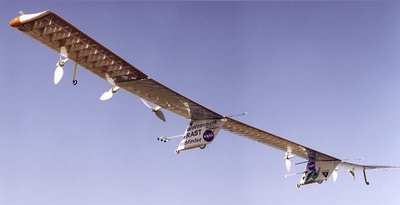Fri, Jun 27, 2003
Breaks Up Over The Pacific At 8000 Feet
 An extraordinary NASA research
project has had a serious accident. The remotely operated Helios
Prototype aircraft, a proof-of-concept solar-electric flying wing
designed to operate at extremely high altitudes for long duration,
was destroyed when it crashed Thursday during a checkout flight
from the Navy’s Pacific Missile Range Facility (PMRF) on the
Hawaiian island of Kauai.
An extraordinary NASA research
project has had a serious accident. The remotely operated Helios
Prototype aircraft, a proof-of-concept solar-electric flying wing
designed to operate at extremely high altitudes for long duration,
was destroyed when it crashed Thursday during a checkout flight
from the Navy’s Pacific Missile Range Facility (PMRF) on the
Hawaiian island of Kauai.
There was no property damage or injuries on the ground resulting
from the accident. The remotely piloted aircraft came down within
the confines of the PMRF test range over the Pacific Ocean west of
the facility. The cause of the mishap is not yet known.
The solar-electric, propeller-driven aircraft had been flying
under the guidance of ground-based mission controllers for
AeroVironment, Inc., of Monrovia, Calif., the plane’s builder
and operator. The lightweight flying wing had taken off from PMRF
at about 10:06 a.m. on a functional checkout flight and had been
aloft for about 29 minutes over the PMRF test range when the mishap
occurred. The mishap occurred during a shakedown mission in
preparation for a long-endurance mission of almost two days that
had been planned for next month.
The Helios Prototype is one of several remotely piloted aircraft
whose technological development has been sponsored and funded by
NASA under the Environmental Research Aircraft and Sensor
Technology (ERAST) program, managed by NASA’s Dryden Flight
Research Center, Edwards, Calif. Current to power its electric
motors and other systems was generated by high-efficiency solar
cells spread across the upper surface of its 247-foot long wing
during the day and by an experimental fuel cell-based electrical
system at night. The Helios Prototype was designed to fly at
altitudes of up to 100,000 feet on single-day atmospheric science
and imaging missions, as well as perform multi-day
telecommunications relay missions at altitudes of 50,000 to 65,000
feet.

The Helios Prototype set a world altitude record for winged
aircraft of 96,863 feet during a flight from the Navy facility at
Barking Sands, Kauai, in August 2001.
An accident investigation team will be formed by NASA and
supported by AeroVironment and the U.S. Navy to determine the exact
cause of the Helios Prototype mishap.
More News
Light Gun A handheld directional light signaling device which emits a brilliant narrow beam of white, green, or red light as selected by the tower controller. The color and type of>[...]
"The journey to this achievement started nearly a decade ago when a freshly commissioned Gentry, driven by a fascination with new technologies and a desire to contribute significan>[...]
Aero Linx: JAARS, Inc. For decades now, we’ve landed planes on narrow rivers and towering mountains. We’ve outfitted boats and vehicles to reach villages that rarely se>[...]
"Our driven and innovative team of military and civilian Airmen delivers combat power daily, ensuring our nation is ready today and tomorrow." Source: General Duke Richardson, AFMC>[...]
Aircraft Conflict Predicted conflict, within EDST of two aircraft, or between aircraft and airspace. A Red alert is used for conflicts when the predicted minimum separation is 5 na>[...]
 ANN's Daily Aero-Term (04.20.24): Light Gun
ANN's Daily Aero-Term (04.20.24): Light Gun Aero-News: Quote of the Day (04.20.24)
Aero-News: Quote of the Day (04.20.24) ANN's Daily Aero-Linx (04.21.24)
ANN's Daily Aero-Linx (04.21.24) Aero-News: Quote of the Day (04.21.24)
Aero-News: Quote of the Day (04.21.24) ANN's Daily Aero-Term (04.21.24): Aircraft Conflict
ANN's Daily Aero-Term (04.21.24): Aircraft Conflict




